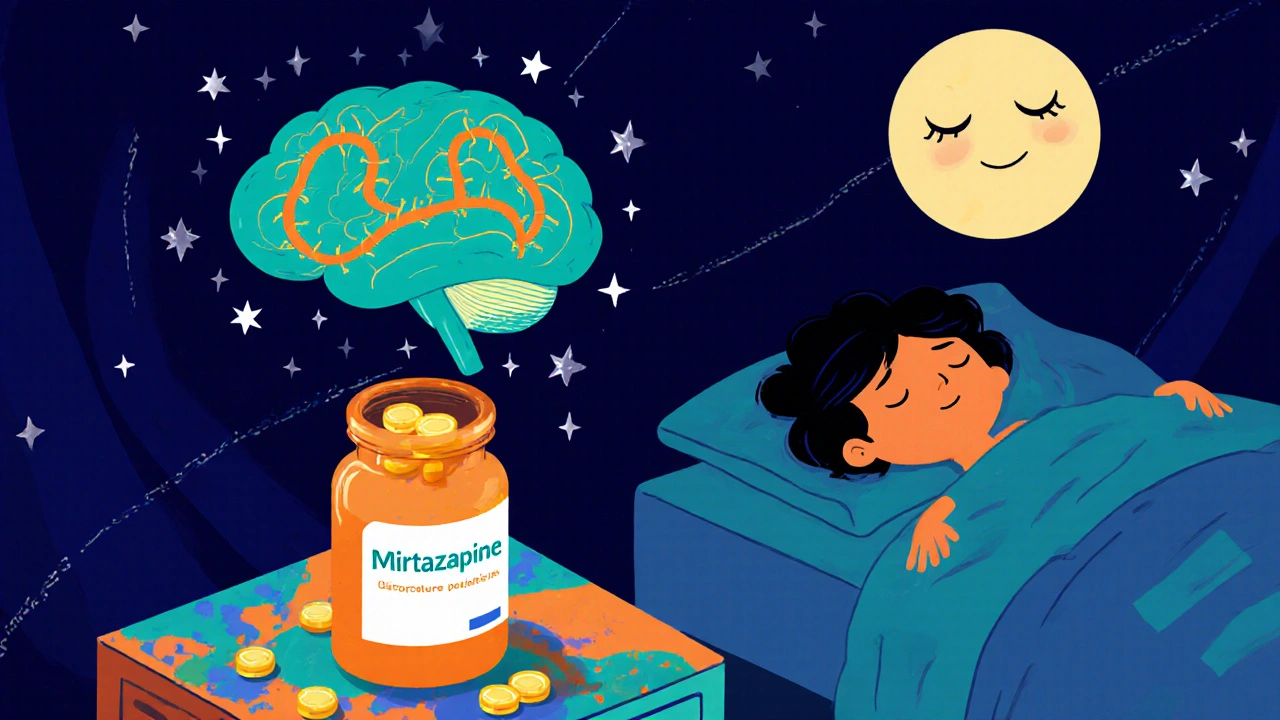Quick Takeaways
- Mirtazapine is an antidepressant that also helps with sleep and appetite.
- Scientific evidence for its use in fibromyalgia is limited but growing.
- Most studies report modest pain relief and improved sleep quality.
- Common side effects include weight gain, drowsiness, and dry mouth.
- It should be considered after first‑line drugs like duloxetine or pregabalin, especially if insomnia is a major complaint.
What Is Fibromyalgia?
Fibromyalgia is a chronic disorder characterized by widespread musculoskeletal pain, fatigue, and sleep disturbances. The condition affects roughly 2-4 % of the adult population, with women making up about 80 % of cases. Though the exact cause remains unclear, researchers think a combination of genetic, neurochemical, and environmental factors leads to an abnormal pain‑processing system in the brain and spinal cord.
Key symptoms include:
- Diffuse tenderness in at least 11 of 18 designated tender points.
- Non‑restorative sleep, often with early‑morning awakening.
- Morning stiffness lasting more than an hour.
- Cognitive difficulties-sometimes called "fibro‑fog."
- Headaches, irritable bowel syndrome, and mood swings.
Because fibromyalgia involves both pain and mood pathways, many clinicians turn to medicines that target neurotransmitters, especially serotonin and norepinephrine.
How Does Mirtazapine Work?
Mirtazapine is a tetracyclic antidepressant that blocks presynaptic alpha‑2 adrenergic receptors, resulting in increased release of serotonin and norepinephrine. At the same time, it antagonises specific serotonin receptors (5‑HT2 and 5‑HT3) and histamine H1 receptors, which explains its strong sedative effect. The drug is approved for major depressive disorder, but its profile-especially the sedation and appetite stimulation-makes it a candidate for conditions where pain, anxiety, and insomnia overlap.
In fibromyalgia, the heightened pain response is partly driven by reduced inhibitory neurotransmission. By boosting serotonin and norepinephrine, mirtazapine may restore some of that inhibition, while the antihistamine action helps patients fall asleep faster and stay asleep longer.
Evidence: Does Mirtazapine Help Fibromyalgia Symptoms?
Peer‑reviewed research on mirtazapine for fibromyalgia is still sparse, but a few small trials and case series give us a glimpse.
- Open‑label pilot (2018, 30 participants): Patients received 15 mg of mirtazapine nightly for eight weeks. Pain scores on the Visual Analogue Scale (VAS) dropped from an average of 6.8 to 5.2, and the Pittsburgh Sleep Quality Index (PSQI) improved by 3 points. Side effects were mild, with most participants reporting increased appetite.
- Retrospective chart review (2021, 112 patients): Those prescribed mirtazapine alongside standard therapy (duloxetine or pregabalin) showed a statistically significant reduction in the Fibromyalgia Impact Questionnaire (FIQ) total score compared with controls (‑12 vs. ‑5 points).
- Case series from a pain clinic (2023, 7 patients): All reported better sleep and less morning stiffness after starting 30 mg at bedtime. Two patients discontinued due to excessive daytime sedation.
While these results are promising, the studies share limitations: small sample sizes, lack of placebo control, and short follow‑up periods. Large double‑blind trials are still needed before mirtazapine can be labeled a first‑line fibromyalgia drug.
Potential Benefits for Fibromyalgia Patients
Based on available data and the drug’s pharmacology, mirtazapine may address several fibromyalgia‑related problems at once:
- Pain modulation: Enhanced norepinephrine and serotonin can dampen central sensitization.
- Improved sleep: H1 antagonism leads to quicker sleep onset and fewer nighttime awakenings.
- Reduced anxiety/depression: As an antidepressant, it tackles the mood component that often worsens pain perception.
- Appetite stimulation: For patients with weight loss due to chronic illness, this can be a plus.
Risks and Side Effects You Should Know
Every medication comes with trade‑offs. The most frequently reported adverse events for mirtazapine are:
- Weight gain (average 2-4 kg in the first three months).
- Morning drowsiness, especially at doses ≥30 mg.
- Dry mouth and constipation.
- Increased cholesterol or triglycerides in some patients.
- Rarely, agranulocytosis or severe skin reactions.
Because the drug blocks histamine, it can worsen asthma or allergic conditions. Patients with a history of bipolar disorder should be monitored closely, as antidepressants can trigger manic episodes.

How to Use Mirtazapine for Fibromyalgia
When a clinician decides to try mirtazapine, the usual starting point is a low bedtime dose to capitalize on its sedative effect while minimizing daytime sleepiness.
- Start low: 15 mg taken 30 minutes before bedtime.
- Assess after two weeks: Check pain VAS, sleep diary, and mood rating.
- Increase if needed: Raise to 30 mg at night; consider 45 mg only if benefits outweigh sedation.
- Monitor weight and labs: Record weight monthly; lipid panel every three months.
- Plan taper: If discontinuing, reduce by 15 mg every 1-2 weeks to avoid withdrawal symptoms.
It’s essential to keep other fibromyalgia meds stable for at least six weeks before adding mirtazapine, so any changes can be attributed accurately.
How Does Mirtazapine Compare to Other Fibromyalgia Drugs?
| Medication | Primary Mechanism | FDA‑approved for Fibromyalgia? | Typical Dose for Fibromyalgia | Most Notable Side Effects |
|---|---|---|---|---|
| Mirtazapine | α2‑antagonist → ↑ serotonin & norepinephrine; H1 antagonist | No (off‑label) | 15-30 mg nightly | Weight gain, sedation, dry mouth |
| Duloxetine | SNRI - serotonin & norepinephrine reuptake inhibition | Yes | 30-60 mg daily | Nausea, hypertension, insomnia |
| Pregabalin | α2‑δ calcium‑channel ligand | Yes | 150-450 mg daily (divided) | Dizziness, edema, weight gain |
| Milnacipran | SNRI - stronger norepinephrine effect | Yes (EU) | 50-100 mg daily | Headache, nausea, increased heart rate |
Notice that mirtazapine stands out for its sedative qualities, making it a good option when insomnia dominates the clinical picture. In contrast, duloxetine and milnacipran are more balanced for pain and mood without heavy sedation.
Practical Checklist Before Starting Mirtazapine
- Confirm diagnosis of fibromyalgia using ACR 2016 criteria.
- Review current medications for interactions (e.g., other CNS depressants).
- Screen for history of bipolar disorder or severe mania.
- Discuss potential weight gain and plan diet/exercise strategies.
- Arrange baseline labs: CBC, fasting lipids, liver function.
- Set clear treatment goals: pain reduction ≥20 %, sleep efficiency ≥85 %.
- Schedule follow‑up at 2 weeks, then monthly for the first 3 months.
When Mirtazapine Might Not Be Right
Even if the drug looks attractive, certain situations call for caution:
- Patients already struggling with obesity or uncontrolled diabetes.
- Those needing high daytime alertness (e.g., commercial drivers).
- Individuals on multiple antihistamines or sedatives.
- Pregnant or breastfeeding women-safety data are limited.
In these cases, clinicians often prefer duloxetine or low‑dose pregabalin first, reserving mirtazapine for refractory insomnia.
Bottom Line
While mirtazapine isn’t a FDA‑approved fibromyalgia medication, its dual action on mood and sleep makes it a viable off‑label option for patients whose biggest hurdles are pain‑related insomnia and low mood. Expect modest pain relief, more noticeable sleep benefits, and a side‑effect profile that leans toward weight gain and drowsiness. Always pair the drug with non‑pharmacologic strategies-graded exercise, CBT for pain, and good sleep hygiene-to get the best overall result.
Can mirtazapine replace duloxetine for fibromyalgia?
Mirtazapine can help, especially if insomnia is severe, but it isn’t a first‑line choice. Duloxetine has stronger evidence for pain reduction and is FDA‑approved, so most clinicians try duloxetine before considering mirtazapine.
How long does it take to notice a difference?
Patients usually report improved sleep within the first week because of the antihistamine effect. Pain relief, if it occurs, tends to appear after 2-4 weeks of consistent dosing.
Is weight gain unavoidable?
Weight gain is common but not inevitable. Starting at a low dose, monitoring calories, and encouraging regular activity can limit the rise. Some patients even experience no change.
Can I take mirtazapine with pregabalin?
Yes, many physicians combine the two-pregabalin for daytime pain control and mirtazapine for nighttime sleep. Start each drug at a low dose and watch for excessive sedation.
What should I do if I feel too drowsy in the morning?
Try reducing the dose to 15 mg or moving the dose earlier in the evening (e.g., 9 pm). If drowsiness persists, discuss switching to a non‑sedating SNRI.


Written by Connor Back
View all posts by: Connor Back